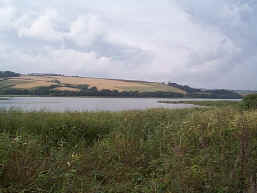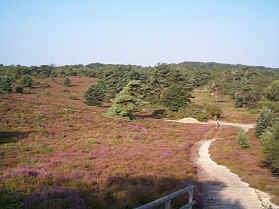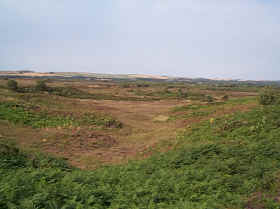Visit your favourite destinations |
Seeking out the South of England Specialities in Devon, John Girdley
For most birders based in the northern areas of the UK, chances to see birds like Cirl Bunting, Dartford Warbler and Cetti's Warbler don't come around very often. However, with a little planning it is quite possible to see all three in a day and have a great days birding.
| Highcliffe House is award winning luxury accommodation in Devon offering Bed & Breakfast overlooking Lynton & Lynmouth in North Devon. The hotel provides romantic guest accommodation within Exmoor National Park. The guesthouse is situated in an acre of garden and woodland, for total peace and tranquility. We offer an oasis of calm to relax and unwind whilst discovering the magnificence of Exmoor. |
The following is an account of a trip, made primarily to see a then resident Sora Rail at Stover Country Park in South Devon: (11th March 2000)
We set of from Lancaster at 2.00am for the long haul down the M6/M5 and arrived at Stover at about 7.00am. A pleasant walk through the park soon found us by a dragonfly pond, the expected stake out of this usually elusive species. After a less than nail-biting two minute wait the Sora showed well at very close range and we were able to study it at leisure. We enjoyed Woodpeckers and Jays flitting around but soon had to decide what to do with the rest of the day.
A Black Duck, seen during the previous week at Slapton Ley became an obvious target.

At the North end of the Ley, a bridge crosses the road and provides a good vantage point. (I saw Hobby and Kingfisher from here, the previous summer) We knew that Cetti's Warblers were present but didn't expect them to be the most vocal birds in the area. Several called from the drier Northern Ley and one posed out in the open from a nearby tree. They make a sound evocative of a Mediterranean spring and once heard are hard to forget.

We had breakfast at the beachside car park, the sea was flat calm and the sun was warming the air. A very close Grebe proved to be a Red-necked and caused us to scrutinise the sea a little more closely. The high-lights were another seven Red-necked Grebes, a Slavonian Grebe, Great Northern and Red-throated Divers plus a group of about twenty Common Scoters.
On the main Ley were two Black-necked Grebes and numerous ducks of most varieties. We failed to find the Black Duck, however. (The smaller Bee Sands Ley just to the south was also checked) Cetti's' Warbler also called from near the car park at Torcross and showed very closely.
Our next port of call was to be Prawle Point, the southern most point of Devon. This is arguably the easiest place in the UK to see Cirl Bunting, though it does involve driving down several miles of exceptionally narrow and windy country roads

Cirl Buntings occur around the car park and along the coastal footpath, we saw several. Prawle is also an excellent place for seeing newly arrived migrants (we missed a fairly predictable Black Redstart by a couple of minutes - and the next day a wandering Booted Eagle flew over!!)
With a clear sea and a SW wind, Prawle also offers excellent sea-watching. I well remember seeing my first Sooty Shearwater off the point, just 100m off shore as the early morning sea mist began to clear one late July several years ago.
Our return took us through Kingsbridge, with Little Egrets in the River mouth by the town car park. (These are still a novelty for Northern based birders!)
Next stop was Burrator Reservoir on the edge of Dartmoor. A fine drake Ring-necked duck was in residence. There were also several Goosander on the lake. The surrounding countryside was superb habitat and one could imagine seeing Whinchat, Redstart and Tree Pipit later in the season.
The final stop was at Aylsbeare Common, about 10 miles east of Exeter. Aylsbeare is a well known Dartford Warbler stake-out, with perfect lowland heath habitat of heather, gorse and isolated hawthorn. It was getting late and it looked likely that everything had gone to roost. A few Stonechat were still showing and so there seemed to be some hope. Eventually one was located and then another but as usual with this species, views were fleeting.
The journey home was long and uneventful, we arrived back at 11.00pm, a long but rewarding day.
Other south coast stake-outs:
Cirl Bunting: The coastal path at Wembury in Devon is usually rewarding. Wembury is perhaps easier to get to than Prawle, being a short drive east from Plymouth and on main roads most of the way.
Cetti's Warbler: Radipole Lake RSPB reserve in Weymouth, Dorset, is one of the easier places to see this species, I have, in the past, seen them from the Swannery car park on the immediate edge of the footpath through the reserve. As always with skulking species, spring is probably the best time to locate them as they call loudly from the reeds and scrub.
Dartford Warbler: In Dorset, Arne RSPB, has Dartford Warbler, this reserve is well worth visiting at any time of the year, and holds a fine range of heathland species. The area around the Shipstall Point view-point is probably the best.

Nearby Winfrith Heath, also in Dorset is even more reliable for this species, there is less cover, the heather is shorter and consequently the birds seem to be easier to see.

Bibliography:
Where to Watch Birds in Devon and Cornwall David Norman
A comprehensive guide to birdwatching sites in Devon and Cornwall. This edition includes extra chapters, "clusters" of sites easily accessible from particular holiday or population centres, information on access for the car-bound or disabled, and an update of recent occurrences at each site.
Where to Watch Birds in Dorset, Hampshire and the Isle of Wight George Green
A guide to birdwatching in Dorset, Hampshire and the Isle of Wight, this details the best bird watching sites ranging from shorelines to woodland. Key information is given on the habitat of each site, the birds likely to be seen there, season by season, with tips on the best time to go for maximum enjoyment. There is also information on the flora and fauna to be found on the site. Necessary practical details are given, accompanied by maps on access and how to get to the site as well as pointers to its suitability for photography, educational facilities, organized group visits and visits by disabled enthusiasts and those with young families.
John Girdley
john@birdtours.co.uk
|
Back to Birdtours.co.uk
|
|
||